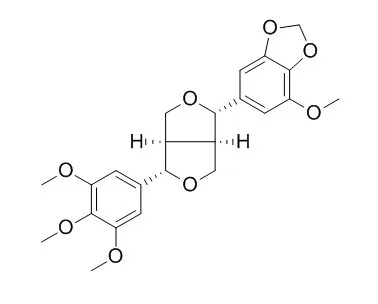The phytochemical profile of Macropiper excelsum (G.Forst.) Miq. subsp. excelsum (Piperaceae), a shrub which is widespread in New Zealand, was investigated by LC-MS-guided isolation and characterization via HR-ESI-TOF-MS and NMR spectroscopy.
METHODS AND RESULTS:
The isolated compounds were sensorily evaluated to identify their contribution to the overall taste of the crude extract with sweet, bitter, herbal and trigeminal impressions. Besides the known non-volatile Macropiper compounds, the lignans (+)-diayangambin and (+)-excelsin, four further excelsin isomers, (+)-diaSesartemin, (+)-Sesartemin, (+)-epiSesartemin A and B were newly characterized. Moreover, piperine and a number of piperine analogues as well as trans-pellitorine and two homologues, kalecide and (2E,4E)-tetradecadienoic acid N-isobutyl amide were identified in M. excelsum, some of them for the first time. Methyl(2E,4E)-7-(1,3-benzodioxol-5-yl)hepta-2,4-dienoate was identified and characterized for the first time in nature.
CONCLUSIONS:
Sensory analysis of the pure amides indicated that they contributed to the known chemesthetic effects of Macropiper leaves and fruits. Since the pungent piperine has been shown to affect glucose and fatty acid metabolism in vivo in previous studies, piperine itself and four of the isolated compounds, piperdardine, chingchengenamide A, dihydropiperlonguminine, and methyl(2E,4E)-7-(1,3-benzodioxol-5-yl)hepta-2,4-dienoate, were investigated regarding their effects on glucose and fatty acid uptake by enterocyte-like Caco-2 cells, in concentrations ranging from 0.1 to 100 μM. Piperdardine showed the most pronounced effect, with glucose uptake increased by 83 ± 18% at 100 μM compared to non-treated control cells. An amide group seems to be advantageous for glucose uptake stimulation, but not necessarily for fatty acid uptake-stimulating effects of piperine-related compounds. |






 Cell. 2018 Jan 11;172(1-2):249-261.e12. doi: 10.1016/j.cell.2017.12.019.IF=36.216(2019)
Cell. 2018 Jan 11;172(1-2):249-261.e12. doi: 10.1016/j.cell.2017.12.019.IF=36.216(2019) Cell Metab. 2020 Mar 3;31(3):534-548.e5. doi: 10.1016/j.cmet.2020.01.002.IF=22.415(2019)
Cell Metab. 2020 Mar 3;31(3):534-548.e5. doi: 10.1016/j.cmet.2020.01.002.IF=22.415(2019) Mol Cell. 2017 Nov 16;68(4):673-685.e6. doi: 10.1016/j.molcel.2017.10.022.IF=14.548(2019)
Mol Cell. 2017 Nov 16;68(4):673-685.e6. doi: 10.1016/j.molcel.2017.10.022.IF=14.548(2019)